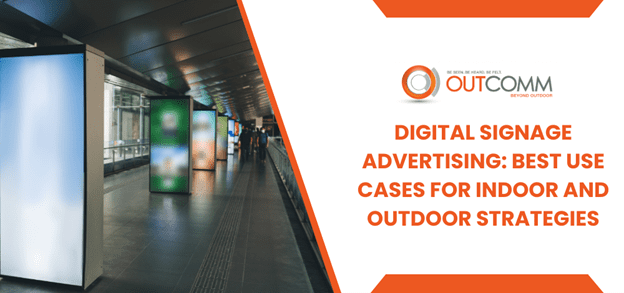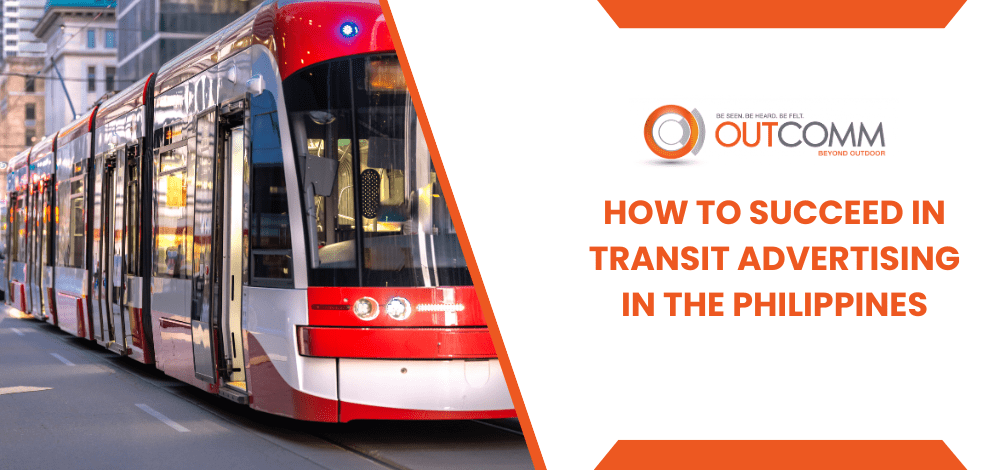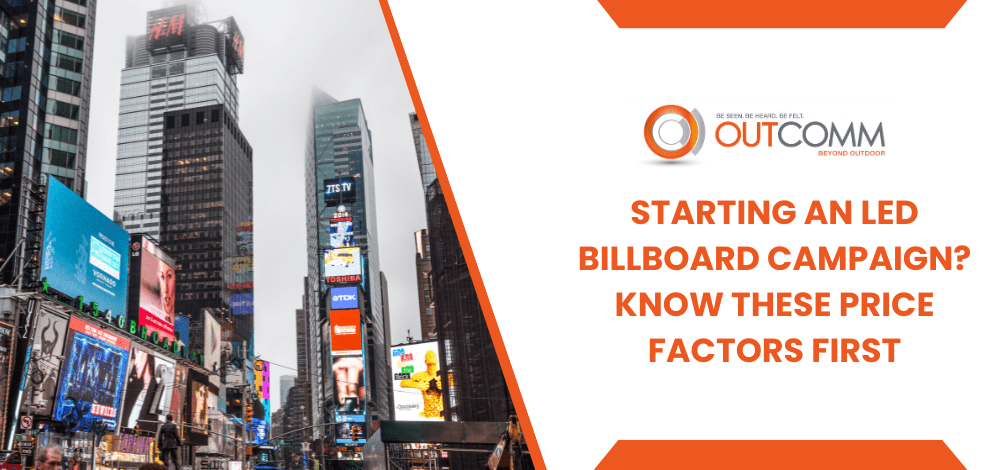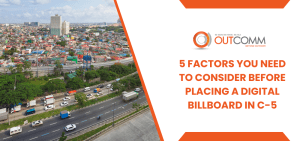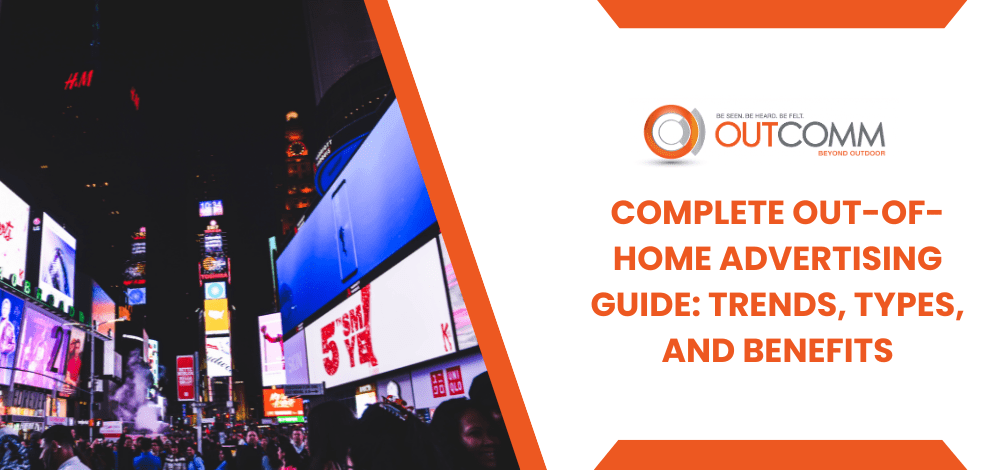
Introduction
Projections in the out-of-home (OOH) advertising industry in the Philippines indicate that this type of brand promotion isn’t going out of style anytime soon. After a lull on the market caused by stay-at-home directives, the industry has a renewed energy today, continuing to pick up traction and filling the city skyline with thought-provoking, striking messages.
Does your brand need a boost in public awareness and recognition? This guide by Outcomm can help you explore the possibilities and benefits of an OOH advertising campaign.
How Is OOH Advertising Different From Other Advertising Types?
OOH advertising in the Philippines is just one of the many channels that companies use to establish their brands. But how is it different from other types of ads? Learning the types of advertisements in the country will provide you with a better understanding of the various campaign options and help you differentiate OOH ads from the rest.
Television Ads – Commercials on television, plugs by celebrities, or a product standing out in a drama series are examples of television ads, which target viewers who usually watch shows at home.
Radio Ads – Targeting AM and FM listeners, radio advertisements are inserted in between playlists or read by the announcer within their program. Not all listeners are at home — in the Philippines, tuning in to radio stations is also popular in public markets.
Print Ads – These ads are typically printed on broadsheets, tabloids, and magazines, with some occupying a whole page. The advertisements are usually situated before or after a relevant section in the printed material.
Online Ads – The advertisements you see on your Facebook feed, go-to blog site, or favorite YouTube video are examples of online advertising today. Like TV and radio ads, they tend to stop you in your tracks as you watch or read something on your screen. These ads are also dependent on what your online habits feed the algorithm.
OOH Ads – Out-of-home ads target people who are not watching, listening, or scrolling through their devices. They target commuters, travelers, and mall-goers, among others, and include billboards, train ads, and wallfinding signs in malls.
OOH ads differ from TV, radio, print, and online ads in their scope and reach. While companies that use traditional ads may have a fixed idea of their target audience based on the TV shows, radio programs, or printed content they leverage, out-of-home ads aim to reach a broader demographic. OOH campaigns target a wide audience, including young and old, students and professionals, men and women — essentially, anyone who can see ads as they walk down the street or drive down the road.
Market Overview and Growth Trends: Is OOH Advertising Still Relevant Today?
For brands, it is crucial to verify if utilizing out-of-home media is still helpful for advertising campaigns in the Philippines. The good news is that the market looks promising. Based on the projected local industry growth, OOH advertising is predicted to reach 316.47 million USD this year.
Moreover, the popularity of new types of OOH advertisements may just be the key for your brand to break into a wider audience. A study by the American Out of Home Advertising Association (OAAA) cites that 80% of consumers take action after seeing an OOH ad they deem entertaining. Some 74% of mobile phone users included in the study stated that they checked the brand on social media or visited their websites. If your intention is to make a lasting impression on the public with your brand, these findings are indicate the ways the OOH approach can help you.
So, is OOH advertising relevant today? Yes, but only if your brand can leverage its use and maximize its potential. A combination of crafting striking messages, utilizing effective formats, and incorporating technology into your campaign can help you achieve optimal results through this advertising channel.
Types of Out-of-Home Advertising in the Philippines Your Brand Should Consider
As its name suggests, out-of-home advertising is the promotional elements you see when you step out of your house. These OOH ads come in different types to target various demographics. Ideally, you would want to put your brand in as many places as possible to reach a wider audience. To maximize results, consider combining the following formats for your campaigns:
Billboards
Billboards are the giant signage that dot the Manila skyline. The main benefit of this format is that, if strategically positioned, it can reach as large an audience as the number of people stuck in traffic or taking the sidewalks and footbridges along main thoroughfares and busy intersections.
Transit Advertising
Transit ads are also known as mobile billboards, and as their name implies, the ads move with the vehicles. They include signs inside train cabs, digital LED signs inside taxi cabs, and stickers at the rear of buses. It delivers ads in a fixed route to reach regular commuters, helping to boost brand recall.
Mall Ads
Mall ads may be a straightforward promotional material for a product, or they can serve a secondary purpose, such as giving people directions. Placed in a contextual location, these types of ads can be an effective way to give people a final nudge to check out your brand while they are near it.
Street Furniture Ads
Ads for street furniture, when done correctly, can enhance the visual appeal of a waiting shed or bus stop while also bringing your brand closer to idle commuters. This type effectively helps in brand recall as they are likely seen by the same passengers taking the same routes regularly.
Strategic Benefits of Out-of-Home Advertising for Brands
How does out-of-home advertising benefit brands in the Philippines? The short answer is that the approach easily raises brand awareness by casting a wide net on all possible demographics. The following advantages can further explain this main benefit:
Allows Wider Reach in High-Traffic Areas
High-traffic areas such as highways, train stations, and malls are prime locations for OOH campaigns. Be sure to seek advertising help for your outdoor media plans to ensure your placements are strategically located and adhere to existing regulations.
Enhances Brand Awareness and Recall
Placing OOH ads where the same people will likely see them can strengthen awareness and recall of your brand. The key is to capture their attention and make a lasting impact the first time — if your messaging resonates with the audience, they will remember it.
Enables Flexibility in Ad Campaigns
Out-of-home advertising in the Philippines, especially when handled by top companies, offers a flexible approach that allows you to utilize various formats to convey your brand’s messaging. You can use billboards, bus ads, or waiting shed signs to reach your target, while the agency you work with recommends the ideal placements for maximum positive results.
Supports Omnichannel Marketing Strategies
If you want to nudge your target audience more effectively, digital out-of-home (DOOH) advertising campaigns in the Philippines can tremendously help you by enabling you to implement omnichannel marketing strategies. With the right planning, your brand can create a seamless experience for your target customers, from the moment they see your ad to the point where they are guided to make a purchase.
Frequently Asked Questions About OOH Advertising in the Philippines
Is Out-of-Home Advertising Effective?
If your main goal is to raise brand awareness and reach a broader audience, then yes, out-of-home advertising is particularly effective. Moreover, your brand’s ad placement improves how it’s perceived by the public. In a current study by the Out of Home Advertising Association of America (OAAA), people find digital OOH ads more favorable and effective in encouraging them to take action than other approaches.
Is Out-of-Home Advertising Expensive?
The cost of out-of-home advertising depends on the location and the potential audience therein. Generally, the wider the reach, the higher the cost of the placement. For instance, a billboard slot along EDSA, where over 400,000 vehicles ply, will cost more than the same format put in other highways with less traffic. To ensure that your placements are not overpriced, ask around for quotes and compare them with industry benchmarks to verify their accuracy.
Where Are the Best Locations for OOH Advertising in the Philippines?
In general, the best locations for OOH advertising in the Philippines are those that have the most foot and vehicle traffic. These places include EDSA and C5, where a significant amount of billboard inventory is already in use. Business districts like Makati and Bonifacio Global City are also prime spots, as many professionals flock here, giving you a captive audience with varying purchasing power.
Shopping districts, particularly inside malls, are also prime locations and best utilized if you want to give a final nudge to your target audience to check out your brand’s products. Intersections, locations near corporate building exits, and transportation hubs also yield substantial foot traffic. They are regularly used by the same pedestrians and commuters, enabling you to repeat your message to the same set of demographics every day.
Conclusion
The out-of-home (OOH) advertising industry in the Philippines is expected to grow in the coming years, as more consumers are attracted to and form a positive perception of the platform. As such, your brand should capitalize on this trajectory. You can start by understanding how OOH ads differ from traditional and online advertising, then learning about the strategic benefits of OOH, and finally choosing an agency to trust for your ad placements.
Our Outcomm team can help you get started with your OOH campaign in Metro Manila and beyond. Contact us today to discuss your needs!

